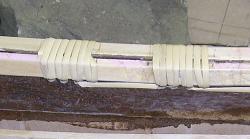

|
ADDING THE GUNWALES: Now the inwales are put in place and clamped along the sheerline at the center section of the hull. Next the outwales are added under the clamps. At the same time the panels are added by inserting their edges between the outwale and the hull. |
| Now a problem arises, having coated both sides of the panels with epoxy it has left the 6 ply panels brittle. Notches where cut in the folded over part of the panel in order to allow visual alignment of the outwale and inwale with the paper. In doing so it's found that the cutout tabs broke off very easily. The folded over part is removed and the panel inserted between the outwale and paper. Next the layout for the rib positions and lashings are done. The ribs will be 1.5 inches in width and spaced 2 inches apart, that is on 3.5 inch centers. This give 31 ribs for the length of 108 inches; perhaps an extra ones will be needed at the headboards. It came out that rib spaces fell under the main thwarts. I could re-layout the rib spacing but having spent a lot of time already laying them out I will work around the rib spaces to install the lashings for the thwarts. With the gunwales installed the two main thwarts are added. | |

|
GUNWALE LASHINGS: Starting at the center of the hull and working alternating between bow and stern the lashings are added to each side of the canoe. The rattan cane being used is 5 - 5.5 mm wide, this size appears to fit the small size of the canoe well. |
| Four small holes are drilled and then elongated into oval slots with rotary cutter in a small hand power tool. Note that the lashings, going left to right, exit the first station at the third hole and enter the next station at the first. This method insures that the horizontal run of the lashings are always under the outwale never under the inwale where they would interfere with the rib ends. A 3/16 hardwood peg is added at each lashing station such that it will be hidden under the lashings. These pegs aid in bonding the inwales and outwales and help resist the tendency of the inwales to rise do to the pressure of the ribs on the inwales. The pegs also help set the gunwales to the sheerline of the canoe. The paper sheet will be further trimmed on approching the stem ends. This canoe style has little rise to the sheer- line until near the bow and stern then it rises quickly. As the lashing approches the stems the building frame is removed from the still open ends of the canoe. Note how the epoxy has turned the tan paper panel dark brown. | |
Previous page................